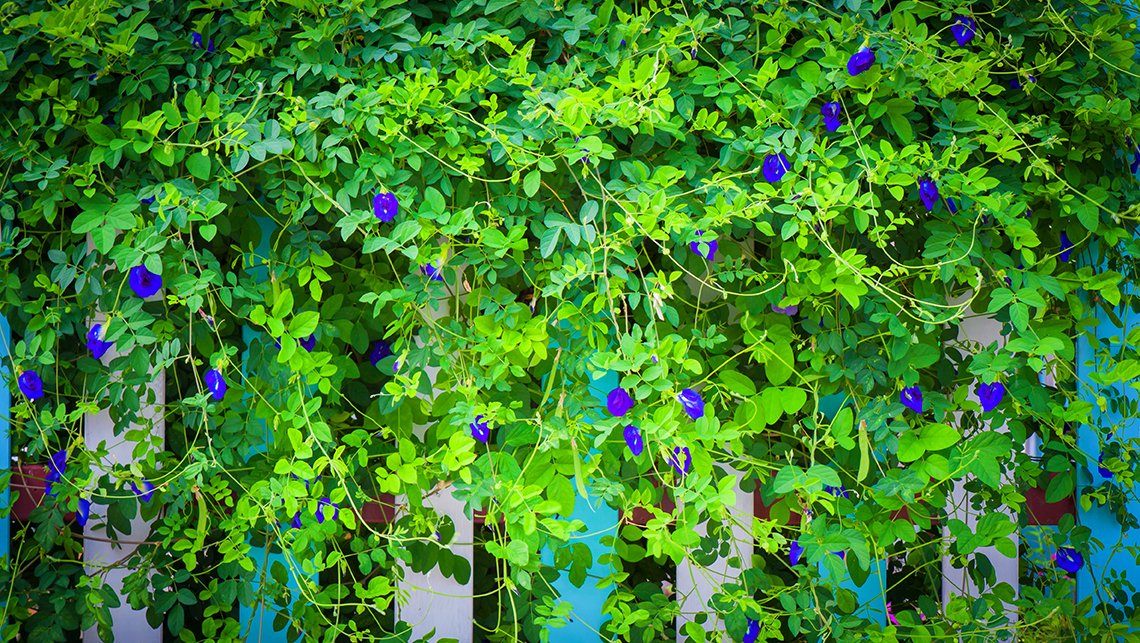 Image 1 of 4
Image 1 of 4

 Image 2 of 4
Image 2 of 4

 Image 3 of 4
Image 3 of 4

 Image 4 of 4
Image 4 of 4





Blue Butterfly Pea
A vining perennial in Zones 10+, this legume grows throughout Asia and has various uses. The plant produces deep blue flowers that are typically used as dye. The flowers are also used to make tea which makes a striking blue color. It has been used for centuries in Ayurveda as a memory enhancer, nootropic, antistress, anxiolytic, antidepressant, anticonvulsant, tranquilizing and sedative agent.
The plant is a rapidly growing vine that can reach up to 5 feet long with lots of side shoots. The leaves and flowers both resemble those of other pea plants. As a legume, the plant fixes nitrogen back into the soil. Butterfly pea prefers full sun and space to climb.
To make tea:
Use one-quarter of a cup of dried butterfly pea flowers per one to two cups of water. Bring the water to a boil, then remove from heat and add your flowers. Allow them to steep until the water has turned a deep purple or indigo, up to eight minutes. It can be served hot or over ice. Then, add lemon juice and sweetener to taste. As you add the lemon juice, watch the color change from purple to pink!
A vining perennial in Zones 10+, this legume grows throughout Asia and has various uses. The plant produces deep blue flowers that are typically used as dye. The flowers are also used to make tea which makes a striking blue color. It has been used for centuries in Ayurveda as a memory enhancer, nootropic, antistress, anxiolytic, antidepressant, anticonvulsant, tranquilizing and sedative agent.
The plant is a rapidly growing vine that can reach up to 5 feet long with lots of side shoots. The leaves and flowers both resemble those of other pea plants. As a legume, the plant fixes nitrogen back into the soil. Butterfly pea prefers full sun and space to climb.
To make tea:
Use one-quarter of a cup of dried butterfly pea flowers per one to two cups of water. Bring the water to a boil, then remove from heat and add your flowers. Allow them to steep until the water has turned a deep purple or indigo, up to eight minutes. It can be served hot or over ice. Then, add lemon juice and sweetener to taste. As you add the lemon juice, watch the color change from purple to pink!
A vining perennial in Zones 10+, this legume grows throughout Asia and has various uses. The plant produces deep blue flowers that are typically used as dye. The flowers are also used to make tea which makes a striking blue color. It has been used for centuries in Ayurveda as a memory enhancer, nootropic, antistress, anxiolytic, antidepressant, anticonvulsant, tranquilizing and sedative agent.
The plant is a rapidly growing vine that can reach up to 5 feet long with lots of side shoots. The leaves and flowers both resemble those of other pea plants. As a legume, the plant fixes nitrogen back into the soil. Butterfly pea prefers full sun and space to climb.
To make tea:
Use one-quarter of a cup of dried butterfly pea flowers per one to two cups of water. Bring the water to a boil, then remove from heat and add your flowers. Allow them to steep until the water has turned a deep purple or indigo, up to eight minutes. It can be served hot or over ice. Then, add lemon juice and sweetener to taste. As you add the lemon juice, watch the color change from purple to pink!
Post pruning you can expect your Moringa tree to look like this the following Spring: